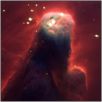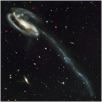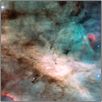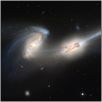 |
|
 |
|
|
Skip
to any page in the
chronology of events.
The higher the number,
the more recent the images. |
|

 Apr
30, 2002 :: First Pictures taken by new ACS camera
released Apr
30, 2002 :: First Pictures taken by new ACS camera
released 
A press briefing was held at NASA headquarters
where officials and scientists unveiled the frist
images taken since the SM3B upgrades. The ACS
camera exceeded expecations in the quality and
speed with which it obtained the following images.
Click
here for more details. |
|

 |
The
Cone Nebula (NGC 2264)
Resembling a nightmarish beast rearing its head
from a crimson sea, this monstrous object is actually
an innocuous pillar of gas and dust. The Cone
Nebula resides 2,500 light-years away in the constellation
Monoceros in a turbulent star-forming region.
|
 |
The
Tadpole Galaxy (UGC 10214)
The tadpole galaxy received its distorted form
by a collison with antoher small hit-and-run galaxy
whose gravitational pull created the long tail
of debris, consisting of stars and gas that stretch
out more than 280,000 light-years. The Tadpole
resides about 420 million light-years away in
the constellation Draco. |
 |
Center
region of the Omega Nebula (M17)
A hotbed of newly born stars wrapped in colorful
blankets of glowing gas and cradled in an enormous
cold, dark hydrogen cloud. The region of the nebula
shown in this photograph is about 3,500 times
wider than our solar system. The nebula, resides
5,500 light-years away in the constellation Sagittarius.
|
 |
The
Mice Galaxies (NGC 4676)
The colliding galaxies have been nicknamed "the
Mice" because of the long tails of stars
and gas emanating from each galaxy. Otherwise
known as NGC 4676, the pair will eventually merge
into a single giant galaxy. This celestial dance
was found 300 million light-years away in the
constellation Coma Berenices. |
|
|
|
|